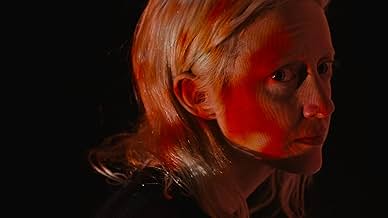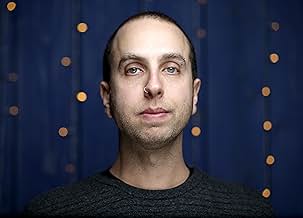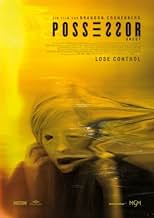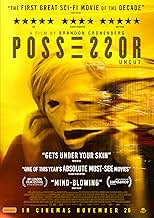Un agente que trabaja para una organización secreta, le es implantado un chip que los lleva a cometer asesinatos para clientes bien pagados.Un agente que trabaja para una organización secreta, le es implantado un chip que los lleva a cometer asesinatos para clientes bien pagados.Un agente que trabaja para una organización secreta, le es implantado un chip que los lleva a cometer asesinatos para clientes bien pagados.
- Dirección
- Guionista
- Elenco
- Premios
- 15 premios ganados y 40 nominaciones en total
- Policeman
- (as Daniel Park)
- Ira Vos
- (as Gage Graham-Arbuthnot)
- Dirección
- Guionista
- Todo el elenco y el equipo
- Producción, taquilla y más en IMDbPro
Opiniones destacadas
The movie has an ethereal kind of narration, which is a good choice, considering the main theme, but the pace is too slow. The director, which is also the main screenwriter, wanted to experiment, by creating strange effects and applying weird sound design and music, which I personally appreciated, but the story is not going on. There are a lot of stuff that are not explained: we never know what this agency is, why it exists, is it some kind of secret government project? Who are these agents? Why they are doing what they are doing? Do they receive a special training? Because none of this is clarified, I did not care about the context nor characters, I could not bound with them. The main character, Tasya Vos, played by Andrea Riseborough, has clearly some personal issue with the ex fiancée, or maybe husband, I don't get to know, but why her relationship is broken? What happened? Is it because of her job? You see how many questions I am writing in this review? There tons of plot holes.
After an interesting and involving intro, the screenplay starts to crumble. I have understood that the director wanted to keep a mistery-vibe, but you cannot keep your audience completely blind for the entire movie. There was a lot of potential, but it was wasted, because the director decided to play too much with visual effects, instead on focusing more on the story.
We've got mind-body duality of implanted techno body horror (from the son of the master of the subgenre) instead of dreamscape "Inception" (2010), but nonetheless for some generic corporatist plot. There's a bit of "The Puppet Masters" or "Invasion of the Body Snatchers" to the scenario, as well. An actress (Andrea Riseborough) playing a character that also is an actress--practicing her lines, fine-tuning facial expressions until literally embodying her character. It's even in her name, Tasya Vos, meaning "resurrection" and "fox," a symbolically trickster animal. A character who wears other people's faces like a mask and whose nightmare is that one of those people wears her face literally as a mask. Body and mental dysmorphia that becomes bizarre digitally dysmorphic cinematic imagery. Seeing artifacts that aren't there. An identity crisis fully emerging from wearing virtual-reality-like goggles to spy through customers' webcams through the eyes of the body that's consciousness has been hacked via Vos hooked up to another virtual-reality set. It's the sort of film-within-a-film that's within yet another film that really makes a character question their reality.
This is what got me wondering, then, about those objects Vos looks at in her debriefing meetings with Jennifer Jason Leigh's Girder (which may mean "satirist," by the way). Interesting how Leigh has been cast in so many such detached, clinician-type parts, at least of late: "Annihilation" (2018) and "Awake" (2021) being two of the latest movies I've seen with her, in addition to "The Woman in the Window" allusion to her part in "Single White Female" (1992). This is also the actress from "eXistenZ" (1999), "The Machinist" (2004) and "Synecdoche, New York" (2008). There probably aren't many actors out there more trained in the ways of reality-bending cinematic reflexivity. More interesting methinks than her ex-husband's use of meta-narratives as realistic movie therapy sessions.
Cronenberg to Cronenberg, but for the actors, Leigh's satirist grooms another actress as her successor. She monitors her character possessing via virtual-reality headwear, illustrates her slasher exploits with bloody big-screen images, and presents her objects from her past--nominally to distinguish her own identity and reality from those she possesses--but, Girder actually advises Vos to detach herself further, from the family connections that distract her from her work. Noah Baumbach should take note.
All of which makes me wonder about those objects, a pipe and a pinned butterfly. The latter seems to fit the transformation and resurrection themes well enough, but that pipe. And, boy, is there a lot of vaping in this one. A tobacco fix that isn't tobacco. A pipe that isn't actually a pipe. People possessed who aren't actually themselves. Consumers and voyeurs, not people. Pornography instead of sex. Dead images in lieu of reality. Ceci n'est pas une pipe à la René Magritte. This is The Treachery of Images. This isn't reality; it's a representation, surreal, virtual, a movie. "Pull me out."
It is quite slow moving and you do have to pay attention to get the most from it. Personally, I enjoyed it, and it makes a change from the usual sci-fi 'factory' movies churned out by Hollywood.
The acting, writing, and production are superb.
Interesting enough premise. The film is set in a very bleak version of the future where cities appear to be sparsely populated (perhaps from some event that greatly reduced the population such as plague or war; a motif borrowed from Argento's Tenebre). The film relies heavily on psychotropic imagery, and this adds to the overall frightening and confusing atmosphere since most of this imagery is nightmarish (distorted faces reminiscent of David Cronenberg's The Brood, warped colors, bursts of sound and images, blurs, rapid-fire images and strobing flashes of light). The film further relies on ultra-violence as a motif that rivals even the Italian slasher films of the late 1970s and early 80s (such as Susperia, Tenembre, Opera, etc.). Possessor contains explicit sexual motifs including full male nudity and erect penises, which reminds me very much of Antichrist (2009) or The Man Who Fell to Earth (1976). These are juxtaposed with explicit imagery of knives penetrating flesh. All of this results in a nightmare landscape. The ending is purposely left confusing so that that the viewer can arrive at their own conclusions. For some viewers, this will be frustrating.
All of this wraps up into a very worthwhile enough film, but for viewers with a more sophisticated palate (if you are looking for a Blumhouse type film Possessor is not what you are looking for). It is disturbing to be sure. However, it is very well made and anchored by two very outstanding performances from Andrea Riseborough and Christopher Abbott. It also features Jennifer Jason Leigh and Sean Bean in very laudable supporting roles (whether or not Sean Bean dies I will not spoil). Possessor is a "Criterion Collection" caliber film that will give the viewer some satisfaction analyzing and will with you long after you see it.
The entire thing revolves around people that "jockey" other people in order to do very mundane things like assassinations. The very idea is lacking imagination, considering that the premise of this film is killing people for other people that want their money and the very obvious alternative is to jockey the people directly and take their money. And then there is an entire exploration of what it means to inhabit other people's lives and minds, but it goes nowhere other than hallucinating some images.
At least the end was good because the jockey finally got back on track and remembered her work ethic! I am kidding. The end was bad.
Bottom line: an overly long film that shouts "Cronenberg!!!!" but needed very little of the signature characteristics of a Cronenberg movie to tell this story. I hope Brandon will find his own voice rather than bank on the same ideas his father explored. Or was it really Brandon? Maybe his father was jockeying him!
¿Sabías que…?
- TriviaMost of the special effects in the film were done practically, with an effort to use as little VFX work as possible. The hallucination scenes' effects in particular were done in-camera. Cronenberg credits his effects specialists, Dan Martin and Derek Liscoumb, and his longtime cinematographer Karim Hussain for being able to pull off convincing visuals with a minimum of CGI.
- ErroresWhen John Parse is being mutilated, his skin in the close-up shots of the wounds on his face looks completely different than it does in the rest of the scene. Mainly, it has a different color and is much smoother.
- Citas
Colin Tate: Just think, one day your wife is cleaning the cat litter and she gets a worm in her, and that worm ends up in her brain. The next thing that happens is she gets an idea in there, too. And it's hard to say whether that idea is really hers or it's just the worm. And it makes her do certain things. Predator things. Eventually, you realize that she isn't the same person anymore. She's not the person that she used to be. It's gotta make you wonder, whether you're really married to her... or married to the worm.
- Versiones alternativasPossessor exists as a cut US R rated version and an uncut MPA Unrated Version titled Possessor Uncut. The producers were keen to differentiate between the two versions and the 'Uncut' tag is an official re-titling of the film. UK releases are the Uncut Version and are 18 rated.
- ConexionesFeatured in Possessor/Possessor Uncut Review (What's the difference?) (2020)
Selecciones populares
- How long is Possessor?Con tecnología de Alexa
Detalles
- Fecha de lanzamiento
- Países de origen
- Sitios oficiales
- Idioma
- También se conoce como
- Possessor
- Locaciones de filmación
- Toronto, Ontario, Canadá(Shot on location)
- Productoras
- Ver más créditos de la compañía en IMDbPro
Taquilla
- Total en EE. UU. y Canadá
- USD 752,885
- Fin de semana de estreno en EE. UU. y Canadá
- USD 252,664
- 4 oct 2020
- Total a nivel mundial
- USD 911,180
- Tiempo de ejecución1 hora 43 minutos
- Color
- Mezcla de sonido
- Relación de aspecto
- 1.78 : 1
Contribuir a esta página









































